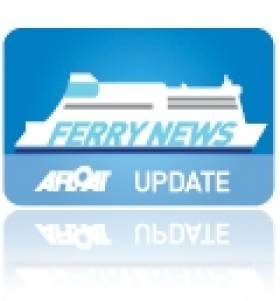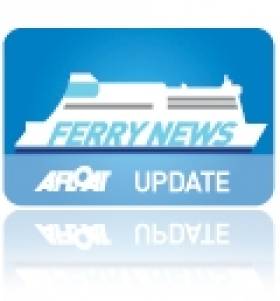Displaying items by tag: New ropax Epsilon
New Third Dublin Route Ferry Completes Repositioning Voyage from Italy
#EpsilonArrives– Epsilon's first visit to Dublin Port last night completes the end of her repositioning voyage from Sicily last week, which included a call via Gibraltar, writes Jehan Ashmore.
The three-year charter of Epsilon to Irish Ferries is expected to see the 500 passenger ro-pax introduced as the third vessel on the Dublin-Holyhead in the run-up to the busy Christmas season.
Epsilon is to provide two additional departures daily in each direction which will increase sailings to a maximum of twelve serving the core Irish Sea route.
The 2011 built Epsilon which docked this morning at Ocean Pier, a temporary berth, is set to join the routes flagship cruiseferry Ulysses and fastcraft Jonathan Swift. Unlike her fleetmates, Epsilon will not however be catering for 'foot' passengers on any of her sailings.
In addition to the Epsilon sailing on the Irish Sea, the 26,325 tonnes ferry is to launch in the New Year, a new direct service to France between Dublin-Cherbourg starting on 18 January 2014.
The year-round operated continental route will be served only at weekends, when a round-trip sailing schedule will provide a link between the Irish capital and Normandy.
Irish Ferries New ‘Epsilon’ Set for November Debut in Run Up to Seasonal Competition
#NewFERRY - As previously reported, Irish Ferries announcement to boost capacity with a third vessel on the core Dublin-Holyhead increases the competitive stakes with rivals Stena Line in the run up to the festive period, writes Jehan Ashmore.
The chartering of the 500 passenger ro-pax Epsilon (26,375grt) will start this month and not December as previouly indicated. According to the company's website, Epsilon will operate the new additional Dublin -Holyhead sailings of two daily-round trips starting on 24 November.
Currently, Irish Ferries operates eight sailings daily on the key Irish Sea route using its flagship cruiseferry Ulysses and smaller yet fast-ferry Jonathan Swift. The introduction of the Epsilon will increase the company's schedule to a maximum of twelve daily sailings.
The 2011 Italian built vessel has modern facilities including cabins, bar/cafeteria and self-service restaurant and significant vehicle capacity (2,860 lane metres). This allows Irish Ferries to further target both the tourism market and freight customers.
Stena Line's Dublin-Holyhead service has had the upper hand in that they already operate two conventional ferries on the route.
In addition Stena Line operate the seasonal-only (March-Sept) Dun Laoghaire-Holyhead route operated by fast-craft HSS Stena Explorer. She is to reopen the service on 20 December for the Christmas and the New Year periods.































































